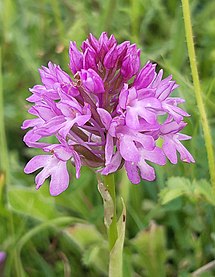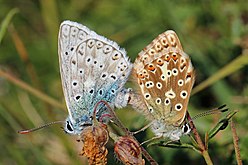Aston Rowant National Nature Reserve
Notification 1988 | | |
| Location map | Magic Map | |
|---|---|---|
Aston Rowant National Nature Reserve is located on the north-west escarpment of the Chiltern Hills, in the Chilterns Area of Outstanding Natural Beauty.[1] It has an area of 159.1 hectares (393 acres),[2] and most of it is a 128.5 hectares (318 acres) biological Site of Special Scientific Interest.[3][4] It is listed as a Grade 1 site in A Nature Conservation Review.[5] The reserve is in several sections, mostly in the parish of Lewknor in Oxfordshire, with smaller sections in the parish of Stokenchurch in Buckinghamshire.
The reserve is home to plants and butterflies of
As well as chalk grassland, the reserve contains woodland with
Habitats

The Aston Rowant reserve is managed by
at Aston Rowant Wood.Flowers
Aston Rowant is especially noted in spring and summer for the wildflowers and orchids associated with close-cropped chalk grassland, managed by careful grazing regimes. Orchid species recorded include
- Flowers at Aston Rowant NNR
-
Small scabious
-
Ragged robin
-
Dog rose
-
Chalk fragrant orchid
-
Yellow rattle
-
Pyramidal orchid
-
Hoary plantain
-
Yellow-wort
Butterflies
The chalk grassland habitat is particularly attractive to many species of butterflies such as the Adonis blue, the chalkhill blue, marbled white, silver-spotted skipper, the dark green fritillary, and the silver-washed fritillary.[6] Over 30 species of butterflies have been recorded on the reserve.
- Butterflies at Aston Rowant NNR
-
Adonis blue, Lysandra bellargus
-
Chalkhill blue, Polyommatus coridon
-
Marbled white, Melanargia galathea
-
Silver-spotted skipper, Hesperia comma
-
Silver-washed fritillary, Argynnis paphia
Mammals
Reintroductions

In 1989, the Aston Rowant NNR became one of the initial four sites selected by the
In the summer of 2004, seeds of the interrupted brome grass, which had become extinct in the wild, were dispersed at the Aston Rowant NNR. The plants successfully germinated, fruited and persisted. This marked the first extinct plant to be re-introduced into the wild in British history.[9]
M40 controversy

The M40 motorway passes through the reserve, where the Aston Rowant Cutting creates an important geological exposure of the Coniacian chalk strata, and drops the motorway down onto the Oxfordshire plain between Junction 5 Stokenchurch and junction 6 Watlington. This section of the "Midlands Link" motorway opened in 1974 after a Public Enquiry. The event helped to motivate conservation groups to oppose infrastructure projects that would damage protected natural habitats, such as the M3 cutting through Twyford Down near Winchester, which could have been protected by tunnelling.[10]
References
- ^ "Oxfordshire's National Nature Reserves". Natural England. Retrieved 25 February 2016.
- ^ "Map of Aston Rowant (NNR)". Natural England. Retrieved 25 February 2016.
- ^ "Aston Rowant citation" (PDF). Sites of Special Scientific Interest. Natural England. Archived from the original (PDF) on 4 March 2016. Retrieved 25 February 2016.
- ^ "Map of Aston Rowant". Sites of Special Scientific Interest. Natural England. Retrieved 25 February 2016.
- ISBN 978-0521214032.
- ^ a b "Oxford Conservation Volunteers: Nature Reserves".
- ^ "Red kite". RSPB. Archived from the original on 26 February 2008. Retrieved 17 February 2022.
- ^ "Re-introduction - Red kites - Caring for the Chilterns | the Chilterns AONB". Archived from the original on 19 May 2009. Retrieved 12 November 2009.
- ^ Randall, David (24 July 2005), "Back from the dead: scientist revives lost plant of old England", The Independent on Sunday, archived from the original on 12 October 2013
- ^ "Newsmedianews | History of the M3 motorway in Hampshire, UK".













